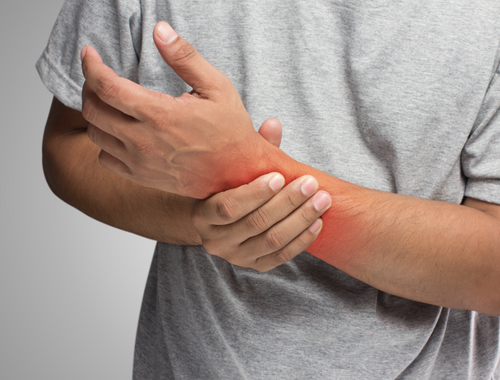Difference Between Paresthesia and Dysesthesia
Paresthesia refers to abnormal burning or tingling sensations that can occur in the extremities. Dysesthesia is a pain that occurs due to nerve fiber damage. It is painful and interferes with the activities of daily living, unlike paresthesia.

What is Paresthesia?
Definition: Paresthesia is a benign, crawling numbing, or itching feeling through the skin. It is commonly referred to as the ‘pins and needles’ sensation in the arms or legs.
Symptoms: Paresthesia commonly affects the extremities. The symptoms of paresthesia may be short-lived or chronic and include the sensation of burning, tingling, weakness, numbness, and stabbing pain.
Causes: Temporary paresthesia is due to brief periods of blood supply cessation in the nerves. Chronic paresthesia is due to nerve damage. Radiculopathy is one of the causes of paresthesia. This can be due to disc herniation or any mass compressing the spinal cord. Neuropathy secondary to trauma, autoimmune diseases, such as rheumatoid arthritis and multiple sclerosis, stroke, connective tissue disorders, tumors, and vitamin deficiencies can also result in paresthesia.
Diagnosis: Full physical and neurologic exams are important for the diagnosis of paresthesia. Blood tests and radiologic investigations, such as X-rays, CT scans, or MRI scans are further done to know the exact cause of the paresthesia.
Treatment: Treatment of the underlying cause of paresthesia is important for controlling it. Vitamin B supplements and physical therapy also prevent peripheral neuropathy.

What is Dysesthesia?
Definition: Dysesthesia occurs due to damage to the central nervous system. It is painful burning, shock-like sensation that occurs mainly in the legs, feet, and hands but can involve any part of the body.
Symptoms: Symptoms of dysesthesia mainly comprise aching, throbbing, burning, shooting, and stabbing pain that may be occasional or persistent.
Causes: Damage to nerves can occur in a multitude of disorders and it presents as dysesthesia. Some conditions that cause dysesthesia include multiple sclerosis, diabetes, Guillain-Barré syndrome, and infective etiologies such as Lyme disease, shingles, and HIV.
Diagnosis: History, physical and neurologic exams along with blood tests are needed to diagnose the cause of dysesthesia.
Treatment: Since dysesthesia affects daily activities and overall quality of life, over-the-counter analgesia is ineffective to resolve it. Drugs that target neuropathic pain include antiseizure agents, such as gabapentin, pregabalin, carbamazepine, and phenytoin. Antidepressants such as amitriptyline and drugs against muscle spasms such as baclofen and also effective treatment choices.
What is the difference between paresthesia and dysesthesia?
Definition
Paresthesia is a crawling, numbing, or itching feeling through the skin, which is commonly referred to as the ‘pins and needles’ sensation. Dysesthesia is a painful burning, shock-like sensation that occurs mainly in the legs, feet, and hands but can involve any part of the body.
Symptoms
The symptoms of paresthesia may be acute or chronic and include burning, tingling, weakness, numbness, and stabbing pain. Symptoms of dysesthesia mainly comprise aching, throbbing, burning, shooting, and stabbing pain that may be occasional or persistent.
Causes
Radiculopathy due to disc herniation or any mass compressing the spinal cord is a leading cause of the paresthesia. Neuropathy secondary to trauma, autoimmune diseases, such as rheumatoid arthritis and multiple sclerosis, stroke, connective tissue disorders, tumors, and vitamin deficiencies can also result in paresthesia. Some conditions that result in nerve damage lead to dysesthesia; these include multiple sclerosis, diabetes, Guillain-Barré syndrome, and infective etiologies such as Lyme disease, shingles, and HIV.
Diagnosis
Full physical and neurologic exams are important for the diagnosis of both paresthesia and dysesthesia. Blood tests and radiologic investigations are further carried out to diagnose the disease.
Treatment
Treatment of the underlying condition mostly resolves paresthesia. Additional help is taken through vitamin B supplements and physical therapy. Treatment of dysesthesia includes drugs that target neuropathic pain such as antiseizure agents like gabapentin, pregabalin, carbamazepine, and phenytoin. Antidepressants such as amitriptyline and drugs against muscle spasms such as baclofen and also effective treatment choices.
Table of differences between paresthesia and dysesthesia

FAQs:
What is the difference between paresthesia and numbness?
Numbness is the loss of sensation in a body part, particularly the extremities. Paresthesia can manifest as numbness, however not always. Sensations such as burning, aching, itching, tingling, and skin crawling are the common symptoms of paresthesia.
What are examples of dysesthesia?
Scalp dysesthesia, cutaneous dysesthesia, and oral dysesthesia are a few examples of dysesthesia.
Can you have dysesthesia without having MS?
Yes. Many other neurologic and infectious conditions are associated with dysesthesia.
What triggers dysesthesia?
Nerve damage triggers dysesthesia.
Can a pinched nerve cause dysesthesia?
Yes. This is seen in radiculopathies.
Can dysesthesia come and go?
Yes. It may be temporary or constant.
How long does dysesthesia last?
It usually lasts for seconds to minutes but can be persistent in rare instances.
Which nerve is most associated with paresthesia?
Ulnar nerve in the arm and sciatic nerve in the thigh.
What neurological conditions cause paresthesia?
Radiculopathies and neuropathies.
What conditions may have dysesthesia as a symptom?
Multiple sclerosis, diabetes, shingles, HIV.
- Differences Between Reptiles and Amphibians - May 17, 2024
- Difference Between Ophthalmology and Optometry - May 15, 2024
- Difference Between Fear and Anxiety - April 2, 2024
Search DifferenceBetween.net :
Leave a Response
References :
[0]Ahmad Emami, Seyed, Amirhossein Sahebkar, and Behjat Javadi. "Paresthesia: A review of its definition, etiology and treatments in view of the traditional medicine." Current pharmaceutical design 22.3 (2016): 321-327.
[1]Borgeat, Alain, et al. "Acute and nonacute complications associated with interscalene block and shoulder surgery: a prospective study." The Journal of the American Society of Anesthesiologists 95.4 (2001): 875-880.
[2]Berić, Aleksandar. "Central pain and dysesthesia syndrome." Neurologic clinics 16.4 (1998): 899-918.
